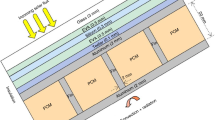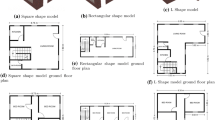Abstract
Utilization of high temperature cooling sources or natural energy sources can potentially contribute to improving energy efficiency in buildings. In this study, a dual-cavity window with gravity-driven cooling mechanism (GDC window) was proposed to integrate the low-grade cooling sources into the glazing system for improving the thermal performance of the window. The embedded pipes circulated with low-grade cooling water are the key component of GDC window, which can remove the absorbed solar heat and reduce the heat gain through the window. A numerical model based on CFD simulation was developed to analyze the flow characteristic and heat transfer within the GDC window. Model validation was conducted by comparing the simulation results with measurement data obtained from previous study. Numerical simulations were carried out to compare the thermal performance of GDC window with that of conventional blinds window. Sensitivity analysis was performed to evaluate the influence of some design parameters on the flow characteristic and thermal performance of GDC window. The simulated results show that compared with the blinds window, the GDC window reduces 57.4% and 40.4% of heat gain in summer for the low-grade cooling water of 18 °C and 25 °C, respectively. Reducing the flow resistance within the GDC window is significant for improving the heat removal performance of the embedded pipes. This study provides an alternative solution to integrate the low-grade cooling sources into the glazing system for enhancing the energy-efficiency and decreasing the building energy demand in cooling-dominated buildings.
Similar content being viewed by others
References
Berardi U, Heidarinejad G, Rayegan S, et al. (2020). Enhancing the cooling potential of a solar-assisted desiccant cooling system by ground source free cooling. Building Simulation, 13: 1125–1144.
BERCTU (2019). 2019 Annual Report on China Building Energy Efficiency. Building Energy Research Center of Tsinghua University (BERCTU). Beijing: China Architecture & Building Press.
Cetiner I, Özkan E (2005). An approach for the evaluation of energy and cost efficiency of glass facades. Energy and Buildings, 37: 673–684.
Chow TT, Li C, Lin Z (2011). Thermal characteristics of water-flow double-pane window. International Journal of Thermal Sciences, 50: 140–148.
Dama A, Angeli D, Larsen OK (2017). Naturally ventilated double-skin facade in modeling and experiments. Energy and Buildings, 144: 17–29.
Gray DD, Giorgini A (1976). The validity of the Boussinesq approximation for liquids and gases. International Journal of Heat and Mass Transfer, 19: 545–551.
Hellsten A (1998). Some improvements in Menter’s k-omega SST turbulence model. In: Proceedings of 29th AIAA, Fluid Dynamics Conference, Albuquerque, NM, USA.
IEA (2018). World Energy Statistics and Balances. Paris: International Energy Agency.
Jarimi H, Lv Q, Ramadan O, et al. (2020). Design, mathematical modelling and experimental investigation of vacuum insulated semi-transparent thin-film photovoltaic (PV) glazing. Journal of Building Engineering, 31: 101430.
Khalifa AJN, Marshall RH (1990). Validation of heat transfer coefficients on interior building surfaces using a real-sized indoor test cell. International Journal of Heat and Mass Transfer, 33: 2219–2236.
Khalvati F, Omidvar A (2019). Summer study on thermal performance of an exhausting airflow window in evaporatively-cooled buildings. Applied Thermal Engineering, 153: 147–158.
Li S, Zou K, Sun G, et al. (2018). Simulation research on the dynamic thermal performance of a novel triple-glazed window filled with PCM. Sustainable Cities and Society, 40: 266–273.
Li C, Li C, Lyu Y, et al. (2020). Performance of double-circulation water-flow window system as solar collector and indoor heating terminal. Building Simulation, 13: 575–584.
Li A, Xiao F, Zhang C, et al. (2021). Attention-based interpretable neural network for building cooling load prediction. Applied Energy, 299: 117238.
Lyu Y, Liu W, Chow TT, et al. (2019). Pipe-work optimization of water flow window. Renewable Energy, 139: 136–146.
Lyu Y, Chow TT (2020). Economic, energy and environmental life cycle assessment of a liquid flow window in different climates. Building Simulation, 13: 837–848.
Lyu W, Li X, Shi W, et al. (2021). A general method to evaluate the applicability of natural energy for building cooling and heating: Revised degree hours. Energy and Buildings, 250: 111277.
Mendis T, Huang Z, Xu S (2020). Determination of economically optimised building integrated photovoltaic systems for utilisation on facades in the tropical climate: A case study of Colombo, Sri Lanka. Building Simulation, 13: 171–183.
Peng J, Curcija DC, Lu L, et al. (2016). Numerical investigation of the energy saving potential of a semi-transparent photovoltaic double-skin facade in a cool-summer Mediterranean climate. Applied Energy, 165: 345–356.
Pierucci A, Cannavale A, Martellotta F, et al. (2018). Smart windows for carbon neutral buildings: A life cycle approach. Energy and Buildings, 165: 160–171.
Shen C, Li X (2016a). Thermal performance of double skin facade with built-in pipes utilizing evaporative cooling water in cooling season. Solar Energy, 137: 55–65.
Shen C, Li X (2016b). Solar heat gain reduction of double glazing window with cooling pipes embedded in venetian blinds by utilizing natural cooling. Energy and Buildings, 112: 173–183.
Shen C, Li X (2017). Potential of utilizing different natural cooling sources to reduce the building cooling load and cooling energy consumption: A case study in Urumqi. Energies, 10: 366.
Shen C, Li X, Yan S (2017). Numerical study on energy efficiency and economy of a pipe-embedded glass envelope directly utilizing ground-source water for heating in diverse climates. Energy Conversion and Management, 150: 878–889.
Skaff MC, Gosselin L (2014). Summer performance of ventilated windows with absorbing or smart glazings. Solar Energy, 105: 2–13.
Somasundaram S, Chong A, Wei Z, et al. (2020). Energy saving potential of low-e coating based retrofit double glazing for tropical climate. Energy and Buildings, 206: 109570.
Wang J, Du Q, Zhang C, et al. (2018). Mechanism and preliminary performance analysis of exhaust air insulation for building envelope wall. Energy and Buildings, 173: 516–529.
Wang Y, Chen Y, Li C (2019). Airflow modeling based on zonal method for natural ventilated double skin facade with Venetian blinds. Energy and Buildings, 191: 211–223.
Zeyninejad Movassag S, Zamzamian K (2020). Numerical investigation on the thermal performance of double glazing air flow window with integrated blinds. Renewable Energy, 148: 852–863.
Zhang C, Wang J, Xu X, et al. (2016). Modeling and thermal performance evaluation of a switchable triple glazing exhaust air window. Applied Thermal Engineering, 92: 8–17.
Zhang C, Gang W, Wang J, et al. (2018). Experimental investigation and dynamic modeling of a triple-glazed exhaust air window with built-in venetian blinds in the cooling season. Applied Thermal Engineering, 140: 73–85.
Zhang C, Gang W, Wang J, et al. (2019). Numerical and experimental study on the thermal performance improvement of a triple glazed window by utilizing low-grade exhaust air. Energy, 167: 1132–1143.
Zhang C, Wang J, Li L, et al. (2021). Condensation risk of exhaust air heat recovery window system: Assessment, key parameters, and prevention measure. Case Studies in Thermal Engineering, 24: 100830.
Zhao T, Wang J, Xu M, et al. (2020). An online predictive control method with the temperature based multivariable linear regression model for a typical chiller plant system. Building Simulation, 13: 335–348.
Zheng D, Chen Y, Liu Y, et al. (2020). Experimental comparisons on optical and thermal performance between aerogel glazed skylight and double glazed skylight under real climate condition. Energy and Buildings, 222: 110028.
Zhou J, Chen Y (2010). A review on applying ventilated double-skin facade to buildings in hot-summer and cold-winter zone in China. Renewable and Sustainable Energy Reviews, 14: 1321–1328.
Acknowledgements
This research has received the support from the National Natural Science Foundation of China (No. 51808239) and the Hong Kong Scholars Program (No. XJ2019044).
Author information
Authors and Affiliations
Corresponding authors
Rights and permissions
About this article
Cite this article
Li, L., Zhang, C., Xu, X. et al. Simulation study of a dual-cavity window with gravity-driven cooling mechanism. Build. Simul. 15, 1339–1352 (2022). https://doi.org/10.1007/s12273-021-0848-x
Received:
Revised:
Accepted:
Published:
Issue Date:
DOI: https://doi.org/10.1007/s12273-021-0848-x




